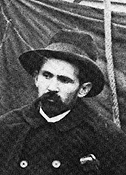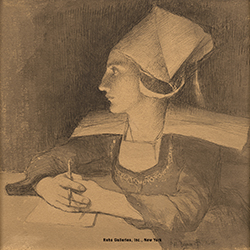BIOGRAPHY - Pascal-Adolphe-Jean Dagnan-Bouveret (1852 - 1929)

Pascal-Adolphe-Jean Dagnan-Bouveret’s career began with his admission to the Ecole des Beaux-Arts in April 1869 where he initially worked in the studio of Alexandre Cabanel. Like all young Frenchmen at the time, his career was temporarily derailed by the Franco-Prussian War and the Paris Commune of 1870-71, but he resumed his education in 1872, settling comfortably into the studio of Jean-Léon Gérôme. In 1875, Dagnan-Bouveret debuted at the Salon with a depiction of the triumphant Atalanta, the Greek heroine who bested all her male competitors in a footrace.
In addition to the standard Beaux-Arts curriculum in Gérôme’s studio, Dagnan-Bouveret also learned how to use photography as a tool, both for organizing a composition and for keeping a record of potentially useful visual images. Although photography was still a fledgling technique in the 1870s, it would become a crucial tool for many artists later in the century. Many of Dagnan-Bouveret’s paintings reveal the use of thoughtfully posed photographs, combined with traditional compositional sketches in ink or pencil, as the basis for the finished work.[i] In fact, key paintings such as Horses at the Watering Trough, 1884, or The Pardon in Brittany, 1886, were painstakingly developed through preparatory photographs and drawings that were ultimately transferred onto the final canvas.
Dagnan-Bouveret’s work also reveals a carefully crafted fusion of classical academic training with subject matter that is based on the everyday life of ordinary people. As a young artist in 1870s Paris, he was undoubtedly aware of Realist painters such as Gustave Courbet or François Bonvin, but the Dutch genre tradition of illustrating domestic scenes and rural life may have been equally influential. The 1879 painting entitled The Accident, for example, is set in a modest rural interior where a young boy sits anxiously on a chair while a doctor wraps his wounded arm. Unpretentious copper pitchers and pots gleam on the mantel above a massive hearth, while the extended family gathers around a trestle table to watch the medical procedure. Their ragged clothes are a marked contrast to the more fashionable—and prosperous—suit that the doctor wears. This type of narrative painting is immediately clear to any viewer regardless of educational background; understanding the story does not depend on knowledge of classical Greek and Roman literature.
Similarly, Dagnan-Bouveret embraced the Realist dictum to paint ‘modern life’. In the ink drawing of A Bird Charmer in the Tuileries Gardens, 1879, he created a beguiling image of contemporary Parisian street life. A year later, in The Laundress, he inserts himself and his close friend Gustave Courtois into an enigmatic scene of a weary young laundress seated on a park bench. As she rests from her labors, the distinctive figures of Dagnan-Bouveret and Courtois stroll through the autumn cityscape, seemingly oblivious to the attractive young woman. In both of these images, the artist rejects sentimental commentary, refusing to impose any interpretation, but instead asking the viewer to determine the meaning.
With his career firmly launched by the late 1870s, Dagnan-Bouveret turned his attention to more personal matters when he married Courtois’ cousin, Anne-Marie, in 1879. The couple met during the artist’s numerous visits to his friend’s home in the Franch-Comté, and it was to this region that Dagnan-Bouveret would return repeatedly in the decades to come. Anne-Marie’s influence on her husband’s work is especially evident in the religious images that begin to appear in the 1880s and eventually become the primary theme of his work.
Throughout the 1880s and 1890s, Dagnan-Bouveret developed a very successful career in a variety of genres; he continued to create naturalist images of daily life, both urban and rural, and increasingly focusing on religious painting. In 1886, he began a series of paintings on the theme of the Breton custom of the “pardon”, an annual pilgrimage associated with the feast day of the patron saint of a local church. Clothed in traditional Breton costumes, pilgrims would gather on the eve of the feast day for confession, and then rise for early morning mass and a day of prayer. Following the worship services, they walked in procession around the church where others who wished to offer prayers of gratitude could join in, often carrying objects such as crutches that were no longer needed. This unique combination of theatricality, unsullied rural custom, and Christian piety were appealing not only to Dagnan-Bouveret, but also to the countless other artists who would travel to Brittany in the closing years of the nineteenth century.
The series of paintings on the Brittany pardons also opened the door for Dagnan-Bouveret’s exploration of other religious subjects. In the late 1880s, he began creating paintings of the Madonna, using the Renaissance example of Raphael as inspiration, but transforming the image into a contemporary Symbolist meditation. The Consolatrix Afflictorium (The Consoling Madonna) of 1899 depicts a mystically lit forest where the Madonna and Child, surrounded by angels, offer divine comfort to a kneeling man. This message of solace found a ready buyer in the American art collector Henry Clay Frick, who had recently lost his young son.[ii]
At the Exposition Universelle of 1900, Dagnan-Bouveret’s status as a respected artistic leader enabled him to showcase his paintings, including The Lord’s Last Supper, in a separate installation on the fairgrounds. The size of this work, at nearly 10 x 18 feet, was intended to create a sense of immediacy, as if the viewer were a witness to the crucial Thursday evening meal. As with his Madonna paintings, Dagnan-Bouveret based the composition of The Lord’s Last Supper on Renaissance models, but the mystical lighting spotlights very contemporary French faces on the apostles.
In November of 1900, Dagnan-Bouveret’s was elected to the Académie des Beaux-Arts of the Institut de France, one of the youngest painters to ever receive this honor. Although often overwhelmed by the swift developments of modernism in the opening decades of the twentieth century, he continued to paint religious images as well as portraits until his death in 1929. In the twenty-first century, his work has been reevaluated—and celebrated—with a 2002 exhibition sponsored by the Dahesh Museum in New York
By: Janet Whitmore, Ph.D.
Museum collections
Art Institute of Chicago
Bayerische Staatsgemälde-sammlungen, Munich
Carnegie Museum of Art, Pittsburgh
Chrysler Museum of Art, Norfolk, Virginia
Ecole Nationale Supérieure des Beaux-Arts, Paris
Hermitage Museum, St. Petersburg
Metropolitan Museum of Art
Montreal Museum of Fine Arts
Musée des Beaux-Arts, Arras
Musée des Beaux-Arts, Lyon
Musée Georges Garret, Vesoul
Musée Municipale, Melun
Museum of Fine Arts, Boston
Philadelphia Museum of Art
Pushkin Museum of Fine Arts, Moscow
Pyms Gallery, London
Walters Art Museum, Baltimore
Awards
Société des Artistes Françaises, Paris
1878: Third Class medal for Manon Lescaut
1880: First class medal for The Accident
1885: Medal of Honor for Horses at the Watering Trough
1889: Grand Prize for Breton Women at a Pardon
[i] For a discussion of Dagnan-Bouveret’s extensive use of photography, see Gabriel P. Weisberg, Against the Modern: Dagnan-Bouveret and the Transformation of the Academic Tradition, (New Brunswick, New Jersey and London: Rutgers University Press, 2002).
[ii] Ibid 114-116.

